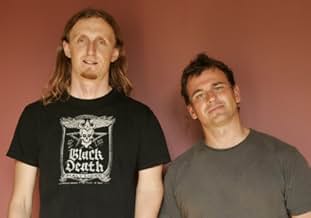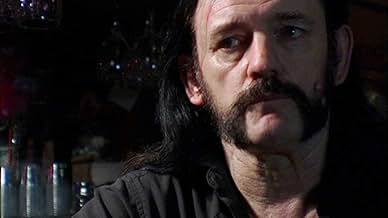Füge eine Handlung in deiner Sprache hinzuAn examination of the heavy metal music subculture that tries to explain why, despite the longevity and popularity of the genre, fans are marginalized and ridiculed for their passion.An examination of the heavy metal music subculture that tries to explain why, despite the longevity and popularity of the genre, fans are marginalized and ridiculed for their passion.An examination of the heavy metal music subculture that tries to explain why, despite the longevity and popularity of the genre, fans are marginalized and ridiculed for their passion.
- Regie
- Drehbuch
- Hauptbesetzung
- Auszeichnungen
- 1 Gewinn & 1 Nominierung insgesamt
- Self
- (as Denis 'Piggy' D'Amour)
- Self
- (as Bob Ezrin)
- Self
- (as George 'Corpsegrinder' Fisher)
Empfohlene Bewertungen
But through him and his collaborators, he is able to get inside not just the off-shoots and specifics of the world of heavy-metal. The look, the style, the attitude, the controversies both domestic (i.e. Dee Snider's battle with Tipper Gore) and foreign (a superlatively done look at the Norwegian black-metal scene, which is both tense and hilarious), the women bands in the world, and how it helps some people really get better on with life either to hear it or play it or, of course, both. Dunn's look is good if, by necessity perhaps too, too brief, as he at one point lists a kind of heavy-metal family tree of sorts- all too quickly to really see every single one- and barely scratches the surface in the 96 minute running time. Maybe there is only so much that can be covered in a feature-length film, but the subject matter serves to be even more looked into; VH1 had also done a heavy-metal documentary, and it lasted four hours. On the other hand, Dunn and his people actually do get some material here that is more precious, and more enlightening. The juxtaposition of the 'true believers' and horrors in Norways black-death-metal scene with a band like Slayer, who are bad to the bone and have fans who go toe limit, is interesting.
It's the kind of documentary that really does work for that it's worth, but not enough of a good thing is explored for fans. Non-fans may get just enough that they can handle, a mix of the basic facts and key points (i.e. the coining of the term 'metal', the roots in the blues, the devil horns, and a look at outrageous album covers). It's good subjective film-making, though edging a little much on trying to get enough history along with the personal history.
What I didn't like too much was the fact that Sam Dunn barely talks about thrash metal. Yeah, he mentions METALLICA, MEGADETH, and there's the SLAYER interview, but this sub genre is the one that gets least mentioned (taking into account today's biggest metal band, METALLICA, arose from the thrash movement).On the other hand, black metal and death metal receive more film time. Maybe Sam Dunn wanted to leave the thrash part less explored due to the upcoming thrash documentary, "GET THRASHED", which has been in the making for at least 4 years.
Minor complaints aside, this documentary rocks and if you're a fan of the genre you'll do no wrong in getting this essential film in your DVD library. Thrash on!!!
I saw this movie at an outdoor summer screening in a local park, and it was brilliant to hear the sounds of the metal we know and love pounding out through the park on a Sunday night.
The film was a considered, thoughtful journey through some of the questions that plague the minds of those who aren't part of the metal community. Such as what the fans are like, how they get into metal, why they stay with metal and rarely stray from the various genres that it has. Others include sexuality, girls in metal, and so on.
Each aspect of the documentary was soundly explored, rationally argued, and balanced. For instance, on the one hand you get the perspective of groupies, and then of groupies from bands. You get differing opinions.
In fact, the documentary is a boon for both the metal community and the non-metal community alike. On the one hand, the mettles can revel in the exploration of their community and genres; on the other, the wider community can gain some real insight into the workings of the community.
I must admit that some of the humour that our (predominantly metal) audience felt at the posturing of the Norwegian Black Metal scene, and other parts, the rest of the audience didn't necessarily get. The humour is often something which you must be part of the community to understand, which is why it all appears so serious to the rest of society: they don't get the humour.
All in all, a well-wrought, skillfully crafted, and well argued documentary. Of course there were subgenres and things missing, but you get that with all docos - there just isn't the time to do it. Given the limitations, Metal: a headbanger's journey, makes the most of it and does it well.
Highly recommended viewing.
The first few seconds into the film, when the all familiar intro of Number of the Beast began, with the clips of metal-heads on screen, I shivered, the hairs on the back of my neck standing up. I felt something very rare, I felt "I'm at home, baby!" \m/ I won't go ramble on about the things everyone knows. Yes, this film is awesome. It has that rare atmosphere, that only a true metal-head could create, like Sam Dunn. If you are a true rocker, you'll feel in sync with the guy, you'll know what he is talking about and why, but if you aren't into metal, you'll have a hard time understanding some of the meaning.
My biggest problem with this doc, is the same as the others: it's too superficial. For me, it's too much about satanism, gore and torching of churches. For me, metal is not about that. Metal is a form of expression, a way of life. I wanted to see more about metal from around the world.
For an anthropologist, Dunn is far too concerned about the different styles of back and death metal, rather than reviewing metal as a phenomenon and culture around the world. He focuses on the US and Norway, but that is just a little piece of the big picture. What about the rest of Europe? What about eastern metal or other regions of the world? What about the other genres of metal? I wanted to hear more about the different genres, the history and pioneers of each of them...etc, how those evolved and transformed over the years, and who are the artists that made it happen.
In a nutshell, it's too one-sided, too narrow perspective. I know it's only 90 minutes, but it could've been done. Okay, I'm maybe splitting hairs here. I agree, it's a decent documentary, and for such an (pardon the term) amateur team, it's a very good film about metal, but it left me with a nagging feeling of "something's missing", it's somehow not complete, and I guess that's what most people are feeling about this documentary. The interviews are very well done, but with the wrong people. I wanted to hear more big names, more name bands and real pioneers of metal. I know the film is very low-budget, and they probably couldn't pay for an interview with Ozzy, Lars, Joacim Cans or even Serj Tankian, but I really miss those bits from a documentary about metal. Other than that, its a pleasant experience, and I recommend it for every metal-head and non-metal-head out there.
Wusstest du schon
- WissenswertesIn one of the film's oft repeated moments, Dunn attempts to interview Mayhem's Necrobutcher at a festival, who clearly appears aggravated at the suggestion that black metal is not as popular as it once was. In 2015, Dunn would interview Necrobutcher again for his Metal Evolution series' "Extreme Metal" episode about the same subject, with a considerably more laid-back Necrobutcher admitting that Dunn's point about black metal being "fractured" to a more melodic and a rawer contingent is a valid one.
- PatzerDunn also mentions the "Filthy 15", a list of artists with lyrics considered obscene in one of a number of ways. Sam mentions that, of the 15, 8 are metal bands- he has miscounted. Upon reviewing the list, Danish black metal band Mercyful Fate make the list but bump the count to 9 bands. They are also not highlighted like the other metal bands sharing spots on the list.
- Zitate
Sam Dunn: Ever since I was 12 years old I had to defend my love for heavy metal against those who say it's a less valid form of music. My answer now is that you either feel it or you don't. If metal doesn't give that overwhelming surge of power that make the hair stand up at the back of your neck, you might never get it, and you know what? That's okay, because judging by the 40,000 metalheads around me we're doing just fine without you.
- VerbindungenFeatures Heavy Metal Parking Lot (1986)
- SoundtracksThe Number of the Beast
Written by Steve Harris (as Stephen Harris)
Performed by Iron Maiden
Licensed courtesy of EMI Records
Top-Auswahl
- How long is Metal: A Headbanger's Journey?Powered by Alexa
Details
Box Office
- Budget
- 1.300.000 $ (geschätzt)
- Weltweiter Bruttoertrag
- 5.095 $
- Laufzeit
- 1 Std. 36 Min.(96 min)
- Farbe
- Sound-Mix
- Seitenverhältnis
- 1.85 : 1






























